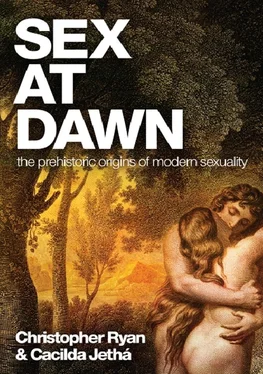Christopher Ryan - Sex at Dawn
Здесь есть возможность читать онлайн «Christopher Ryan - Sex at Dawn» весь текст электронной книги совершенно бесплатно (целиком полную версию без сокращений). В некоторых случаях можно слушать аудио, скачать через торрент в формате fb2 и присутствует краткое содержание. Жанр: Прочая научная литература, на английском языке. Описание произведения, (предисловие) а так же отзывы посетителей доступны на портале библиотеки ЛибКат.
- Название:Sex at Dawn
- Автор:
- Жанр:
- Год:неизвестен
- ISBN:нет данных
- Рейтинг книги:4 / 5. Голосов: 1
-
Избранное:Добавить в избранное
- Отзывы:
-
Ваша оценка:
- 80
- 1
- 2
- 3
- 4
- 5
Sex at Dawn: краткое содержание, описание и аннотация
Предлагаем к чтению аннотацию, описание, краткое содержание или предисловие (зависит от того, что написал сам автор книги «Sex at Dawn»). Если вы не нашли необходимую информацию о книге — напишите в комментариях, мы постараемся отыскать её.
Sex at Dawn — читать онлайн бесплатно полную книгу (весь текст) целиком
Ниже представлен текст книги, разбитый по страницам. Система сохранения места последней прочитанной страницы, позволяет с удобством читать онлайн бесплатно книгу «Sex at Dawn», без необходимости каждый раз заново искать на чём Вы остановились. Поставьте закладку, и сможете в любой момент перейти на страницу, на которой закончили чтение.
Интервал:
Закладка:
4. Confusingly, the tribe that came to be known as the Flatheads was not one of them, as their heads were “flat,” like the white trappers’, while the neighboring tribes’ heads were bizarrely conical.
5. Grayscale reproduction scanned from Eaton, D.; Urbanek,
5.: Paul Kane’s Great Nor-West, University of British Columbia Press; Vancouver, 1995.
6. In fact, Maryanne Fisher and her colleagues found the opposite; distress was greater if the infidelity involved someone with familial bonds (see Fisher, et al. [2009]).
7. Buss (2000), p. 33.
9. Jetha and Falcato (1991).
10. Harris (2000), p. 1084.
11. For an overview of Buss’s research on jealousy, see Buss
(2000). For research and commentary rebutting his work, see Ryan and Jetha (2005), Harris and Christenfeld (1996), and DeSteno and Salovey (1996).
12. www.epjournal.net/filestore/ep06667675.pdf.
13. Holmberg (1969), p. 161.
14. From an “On Faith” blog post in The Washington Post, November 29, 2007: http://newsweek.washingtonpost.com/onfaith/panelists/richard_dawkins/2007/11/ banishing_the_greeneyed_monste.html.
15. Wilson (1978), p. 142.
1. Presumably, he was reading the sixth edition, published in 1826.
2. Barlow (1958), p. 120.
3. It’s no accident that Darwin was well aware of Malthus’s thinking. Harriet Martineau, an early feminist, economic philosopher, and outspoken opponent of slavery, had been close to Malthus before striking up a friendship with Darwin’s older brother, Erasmus, who introduced her to Charles. Had Charles not been “astonished to find how ugly she is,” some, including Matt Ridley, suspect their friendship might have led to marriage. It would surely have been a marriage with lasting effects on Western thought (see Ridley’s article, “The Natural Order of Things,” in The Spectator, January 7, 2009).
4. Shaw (1987), p. 53.
5. Darwin (1871/2007), p. 79. Both Malthus and Darwin would have profited from familiarity with MacArthur and Wilson’s (1967) thoughts on r/K reproduction and selection. Briefly, they posit that some species (like many insects, rodents, etc.) reproduce quickly to fill an empty ecological niche. They don’t expect most of their young to survive to adulthood, but they flood the environment quickly (r-selected). K-selected species have fewer young and invest heavily in each of them. Such species are generally in a state of Malthusian equilibrium, having already reached a population/food supply stasis point. Thus, these questions: as Homo sapiens is clearly a K-selected species, at what point did our environmental niche become saturated? Or have we continually found ways to expand our niche as human population expanded? If so, what does this mean for the underlying mechanisms of natural selection when applied to human evolution?
6. For example: “In the roughly 2 million years our ancestors lived as hunters and gatherers, the population rose from about
10,000 protohumans to about 4 million modern humans. If, as we believe, the growth pattern during this era was fairly steady, then the population must have doubled about every quarter million years, on average.” Economics of the Singularity, Robin Hanson, http://www.spectrum.ieee.org/jun08/6274.
7. Source: U.S. Census Bureau: http://www.census.gov/ipc/www/worldhis.html.
8. Lilla (2007).
9. Smith’s essay is online at http://realhumannature.com/Ppage_icU26.
10. Hassan (1980).
11. For a different take on how and why prehistoric population levels grew so slowly, see Harris (1977), particularly Chapter 2. For yet another take, see Hart and Sussman (2005), who argue that our ancestors did in fact live in Hobbesian fear—but not from each other so much as from constant predation. Malthus acknowledged the low population growth of Native Americans, but he attributed it to lack of libido caused by food shortages, “phlegmatic temperament,” or “a natural defect in their bodily frame” (I. IV. P. 3).
12. Most of the other species of hominids that had spread from Africa to Asia and Europe previously were already long gone by the time modern humans wandered out of Africa. Those still hanging on, Neanderthals and (possibly) Homo erectus, would have been at a huge disadvantage if there was interspecies competition—which is unclear. One could argue that the presence of Neanderthals in Europe and parts of Central Asia may have led to competition over hunting areas,
but the extent of contact between our ancestors and
Neanderthals, if any, is unresolved. Also, any overlap would have been partial, as Neanderthals appear to have been top-level carnivores, while Homo sapiens are and were enthusiastic omnivores (see, for example, Richards and Trinkaus, 2009).
13. The question of when humans first arrived in the
Americas is unresolved. Recent archaeological finds in Chile suggesting human settlements dating to about 35,000 years ago have thrown open the question of how and when the first humans arrived in the western hemisphere. See, for example, Dillehay et al. (2008).
14. See Amos and Hoffman (2009), for example.
Paleoanthropologist John Hawkes isn’t convinced that
population bottlenecks necessarily imply sparse prehistoric human populations overall, proposing that “many small groups of humans were in fact competing intensively, and many of them failed to persist over the long term. In other words, a small effective size is hardly evidence of no ancient competition or warfare. It may be the result of intense competition leading to many local extinctions” (see his blog: http://johnhawks.net/node/1894). Given the persistence of hunter-gather populations in the world’s least habitable zones, the relative abundance of the rest of the planet, and the genetic evidence of just a few hundred breeding pairs after the Toba eruption 70,000 years ago (Ambrose, 1998), we aren’t convinced by Hawkes’s scenario of “many local extinctions” due to competition—as opposed to planetary catastrophe.
15. Agriculture itself can be seen as a response to ecological saturation brought about by the combined effects of gradually rising regional population and catastrophic climate change. For example, Nick Brooks, a researcher at the University of East Anglia, argues, “Civilization was in large part an accidental by-product of unplanned adaptation to catastrophic climate change.” Brooks and others argue that the agricultural shift was a “last resort” response to deteriorating environmental conditions. For a comprehensive discussion of how climate change might have provoked agriculture, see Fagan (2004).
16. Known as “geophagy,” dirt eating is common in societies around the world—especially among pregnant and lactating women. Additionally, many otherwise toxic foods containing poisonous alkaloids and tannic acids are cooked along with alkaloid-binding clays. Clay can be a rich source of iron, copper, magnesium, and calcium—all critical during pregnancy.
17. August 5, 2007.
18. http://moneyfeatures.blogs.money.cnn.com/2009/04/30/millionaires-arent-sleeping-well-either/ ?section=money_topstories.
19. See Wolf et al. (1989) and Bruhn and Wolf (1979). Malcolm Gladwell (2008) also discusses Roseto.
20. Sahlins (1972), p. 37.
21. http://www.newyorker.com/online/blogs/books/2009/04/the-exchange-david-plotz.html.
23. Darwin (1871/2007), p. 208.
24. For a more detailed analysis of how modern economic theory plays out (or doesn’t) among non-state societies, see Henrich et al. (2005) and Richard Lee’s chapter titled “Reflections on Primitive Communism,” in Ingold et al. (1988).
Читать дальшеИнтервал:
Закладка:
Похожие книги на «Sex at Dawn»
Представляем Вашему вниманию похожие книги на «Sex at Dawn» списком для выбора. Мы отобрали схожую по названию и смыслу литературу в надежде предоставить читателям больше вариантов отыскать новые, интересные, ещё непрочитанные произведения.
Обсуждение, отзывы о книге «Sex at Dawn» и просто собственные мнения читателей. Оставьте ваши комментарии, напишите, что Вы думаете о произведении, его смысле или главных героях. Укажите что конкретно понравилось, а что нет, и почему Вы так считаете.












